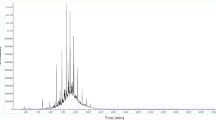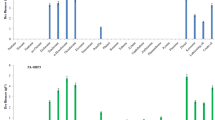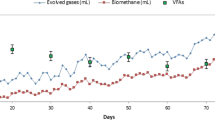Abstract
Biosurfactant production through a fermentation process involving the biodegradation of soybean oil refining wastes was studied. Pseudomonas aeruginosa MR01 was able to produce extracellular biosurfactant when it was cultured in three soybean oil refinement wastes; acid oil, deodorizer distillate and soapstock, at different carbon to nitrogen ratios. Subsequent fermentation kinetics in the three types of waste culture were also investigated and compared with kinetic behavior in soybean oil medium. Biodegradation of wastes, biosurfactant production, biomass growth, nitrate consumption and the number of colony forming units were detected in four proposed media, at specified time intervals. Unexpectedly, wastes could stimulate the biodegradation activity of MR01 bacterial cells and thus biosurfactant synthesis beyond that of the refined soybean oil. This is evident from higher yields of biodegradation and production, as revealed in the waste cultures (Ydeg|(Soybean oil) = 53.9 % < Ydeg|(wastes) and YP/S|(wastes) > YP/S|(Soybean oil) = 0.31 g g−1, respectively). Although production yields were approximately the same in the three waste cultures (YP/S|(wastes) ≃ 0.5 g g−1), microbial activity resulted in higher yields of biodegradation (96.5 ± 1.13 %), maximum specific growth rate (μ max = 0.26 ± 0.02 h−1), and biosurfactant purity (89.6 %) with a productivity of 14.55 ± 1.10 g l−1, during the bioconversion of soapstock into biosurfactant. Consequently, applying soybean oil soapstock as a substrate for the production of biosurfactant with commercial value has the potential to provide a combination of economical production with environmental protection through the biosynthesis of an environmentally friendly (green) compound and reduction of waste load entering the environment. Moreover, this work inferred spectrophotometry as an easy method to detect rhamnolipids in the biosurfactant products.




Similar content being viewed by others
References
Benincasa M, Contiero J, Manresa MA, Moraes IO (2002) Rhamnolipid production by Pseudomonas aeruginosa LBI growing on soapstock as the sole carbon source. J Food Eng 54:283–288. doi:10.1016/S0260-8774(01)00214-X
Chrzanowski Ł, Ławniczak Ł, Czaczyk K (2012) Why do microorganisms produce rhamnolipids. World J Microbiol Biotechnol 28:401–419. doi:10.1007/s11274-011-0854-8
Clarke KG, Ballot F, Reid SJ (2010) Enhanced rhamnolipid production by Pseudomonas aeruginosa under phosphate limitation. World J Microbiol Biotechnol 26:2179–2184. doi:10.1007/s11274-010-0402-y
De Lima CJB, Ribeiro EJ, Sérvulo EFC, Resende MM, Cardoso VL (2009) Biosurfactant production by Pseudomonas aeruginosa grown in residual soybean oil. Appl Biochem Biotechnol 152(1):156–168. doi:10.1007/s12010-008-8188-1
Gautam KK, Tyagi VK (2006) Microbial surfactants: a review. J Oleo Sci 55(4):155–166. doi:10.5650/jos.55.155
Gerba CP, Pepper IL (2009) Wastewater treatment and biosolids reuse. In: Maier RM, Pepper IL, Gerba CP (eds) Environmental microbiology, 2nd edn. Elsevier Inc., USA, pp 503–530
Guerra-Santos LH, Käppeli O, Fiechter A (1984) Pseudomonas aeruginosa biosurfactant production in continuous culture with glucose as carbon source. Appl Environ Microbiol 48(2):301–305
Jagessar RC, Sooknundun L (2011) Determination of nitrate anion in waste water from nine selected areas of coastal Guyana via a spectrophotometric method. Int J Res Rev Appl Sci 7:203–212
Lotfabad TB, Shourian M, Roostaazad R, Najafabadi AR, Adelzadeh MR, Noghabi KA (2009) An efficient biosurfactant-producing bacterium Pseudomonas aeruginosa MR01, isolated from oil excavation areas in south of Iran. Colloids Surf B 69(2):183–193. doi:10.1016/j.colsurfb.2008.11.018
Lotfabad TB, Abassi H, Ahmadkhaniha R, Roostaazad R, Masoomi F, Zahiri HS, Ahmadian G, Vali H, Noghabi KA (2010) Structural characterization of a rhamnolipid-type biosurfactant produced by Pseudomonas aeruginosa MR01: enhancement of di-rhamnolipid proportion using gamma irradiation. Colloids Surf B 81:397–405. doi:10.1016/j.colsurfb.2010.06.026
Makkar RS, Cameotra SS, Banat IM (2011) Advances in utilization of renewable substrates for biosurfactant production. AMB Express 1(5):1–19. doi:10.1186/2191-0855-1-5
Mukherjee S, Das P, Sen R (2006) Towards commercial production of microbial surfactants. Trends Biotechnol 24(11):509–515. doi:10.1016/j.tibtech.2006.09.005
Müller MM, Hörmann B, Kugel M, Syldatk C, Hausmann R (2011) Evaluation of rhamnolipid production capacity of Pseudomonas aeruginosa PAO1 in comparison to the rhamnolipid over-producer strains DSM 7108 and DSM 2874. Appl Microbiol Biotechnol 89:585–592. doi:10.1007/s00253-010-2901-z
Nitschke M, Costa SGVAOC, Contiero J (2010) Structure and applications of a rhamnolipid surfactant produced in soybean oil waste. Appl Biochem Biotechnol 160:2066–2074. doi:10.1007/s12010-009-8707-8
Noudeh GD, Noodeh AD, Moshafi MH, Afzadi MA, Pardakhti A, Salandari M (2010) Investigating the effects of various additives on surface activity and emulsification index of biosurfactant resulting from broth media of Bacillus subtilis PTCC 1023. Afr J Microbiol Res 4(19):1981–1990
Onwosi CO, Odibo FJC (2012) Effects of carbon and nitrogen sources on rhamnolipid biosurfactant production by Pseudomonas nitroreducens isolated from soil. World J Microbiol Biotechnol 28:937–942. doi:10.1007/s11274-011-0891-3
Pitwell LR (1983) Standard COD. Chem. Brit. 19:907
Rahman P, Dusane D, Zinjarde S, Venugopalan V, McLean R, Weber M (2010) Quorum sensing: implications on rhamnolipid biosurfactant production. Biotechnol Genet Eng Rev 27(1):159–184
Saharan BS, Sahu RK, Sharma D (2011) A review on biosurfactants: fermentation, current developments and perspectives. Genet Eng Biotechnol J 2011:GEBJ-29
Salihu A, Abdulkadir I, Almustapha MN (2009) An investigation for potential development on biosurfactants. Biotechnol Mol Biol Rev 3(5):111–117
Sánchez M, Aranda FJ, Espuny MJ, Marqués A, Teruel JA, Manresa Á, Ortiz A (2007) Aggregation behaviour of a dirhamnolipid biosurfactant secreted by Pseudomonas aeruginosa in aqueous media. J Colloid Interface Sci 307(1):246–253. doi:10.1016/j.jcis.2006.11.041
Techaoei S, Leelapornpisid P, Santiarwarn D, Lumyong S (2007) Preliminary screening of biosurfactant producing microorganisms isolated from hot spring and garages in northern Thailand. KMITL Sci Tech J 7(S1):38–43
Thavasi R, Nambaru VRMS, Jayalakshmi S, Balasubramanian T, Banat IM (2011) Biosurfactant production by Pseudomonas aeruginosa from renewable resources. Indian J Microbiol 51(1):30–36. doi:10.1007/s12088-011-0076-7
Wei Y-H, Chou C-L, Chang J-Sh (2005) Rhamnolipid production by indigenous Pseudomonas aeruginosa J4 originating from petrochemical wastewater. Biochem Eng J 27(2):146–154. doi:10.1016/j.bej.2005.08.028
Acknowledgments
The authors gratefully acknowledge the Institute of Genetic Engineering and Biotechnology (NIGEB) for the financial support of this project. They would also like to thank the Behshahr Industrial Company for providing the soybean oil wastes.
Author information
Authors and Affiliations
Corresponding author
Electronic supplementary material
Below is the link to the electronic supplementary material.
11274_2013_1267_MOESM1_ESM.tif
Appendix A Simplified schematic diagram of vegetable oil refining process in Behshahr Industrial Company. Supplementary material 1 (TIFF 872 kb)
11274_2013_1267_MOESM2_ESM.tif
Appendix B Schematic diagram of experimental analyses carried out in different experimental stages. Supplementary material 2 (TIFF 333 kb)
Rights and permissions
About this article
Cite this article
Partovi, M., Lotfabad, T.B., Roostaazad, R. et al. Management of soybean oil refinery wastes through recycling them for producing biosurfactant using Pseudomonas aeruginosa MR01. World J Microbiol Biotechnol 29, 1039–1047 (2013). https://doi.org/10.1007/s11274-013-1267-7
Received:
Accepted:
Published:
Issue Date:
DOI: https://doi.org/10.1007/s11274-013-1267-7




